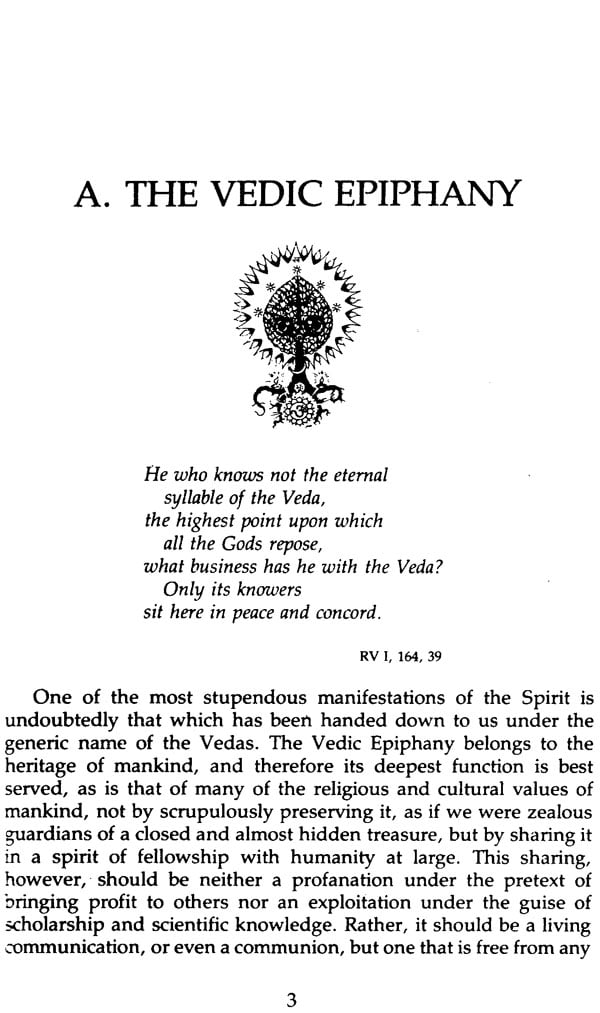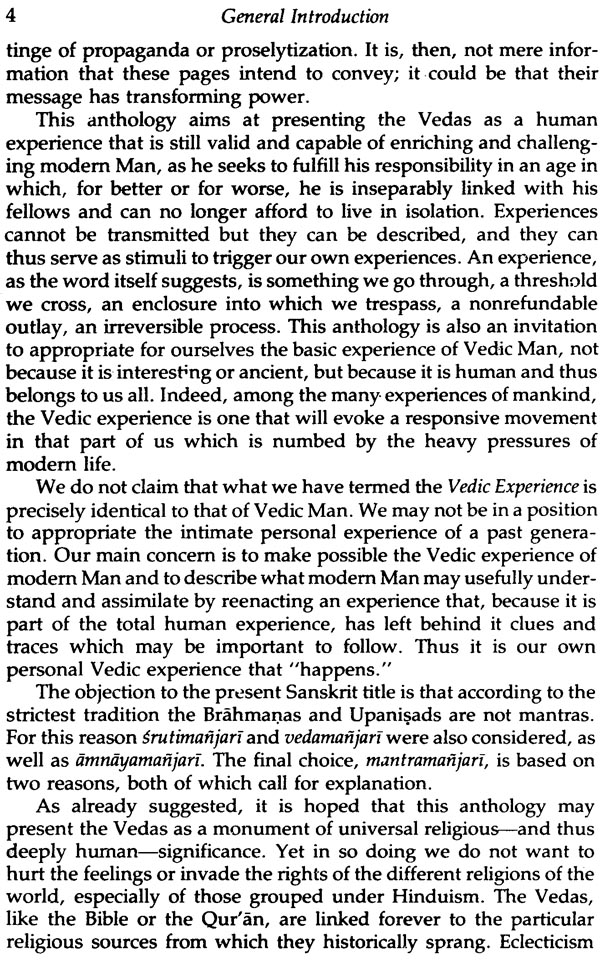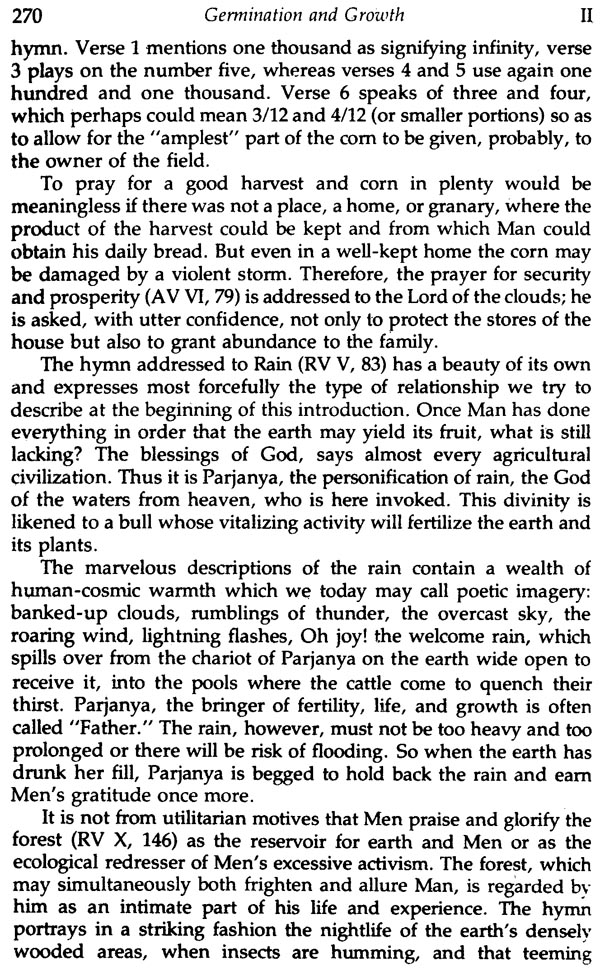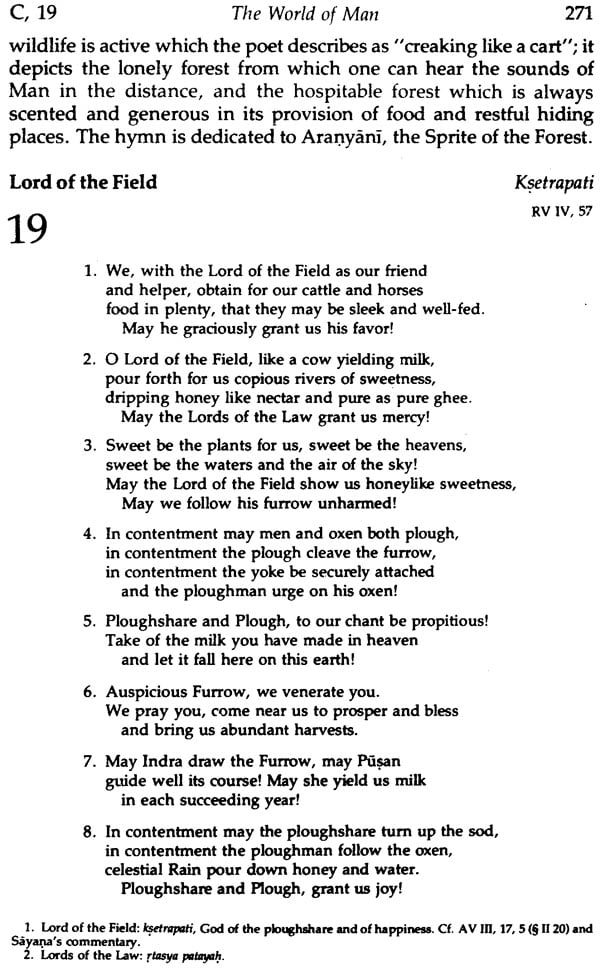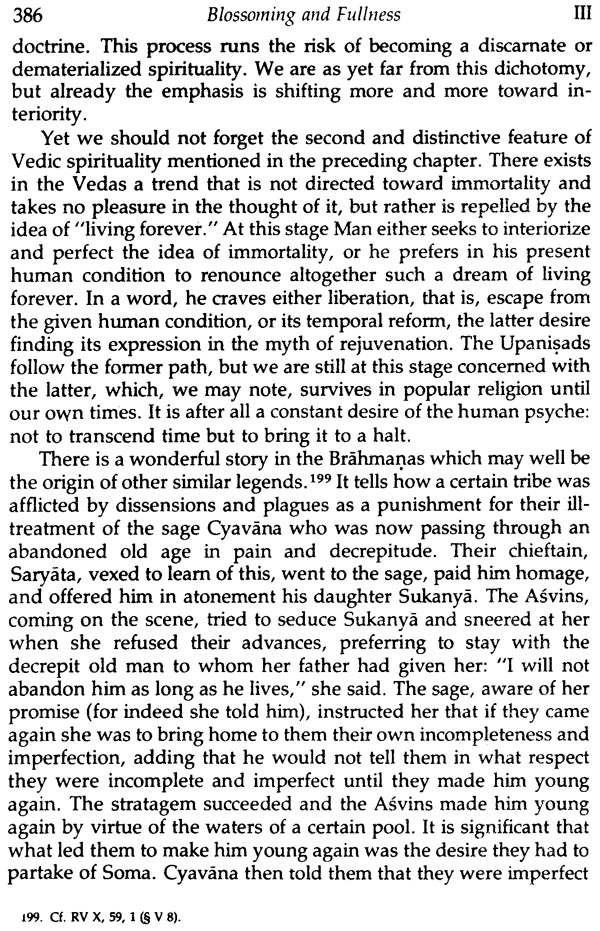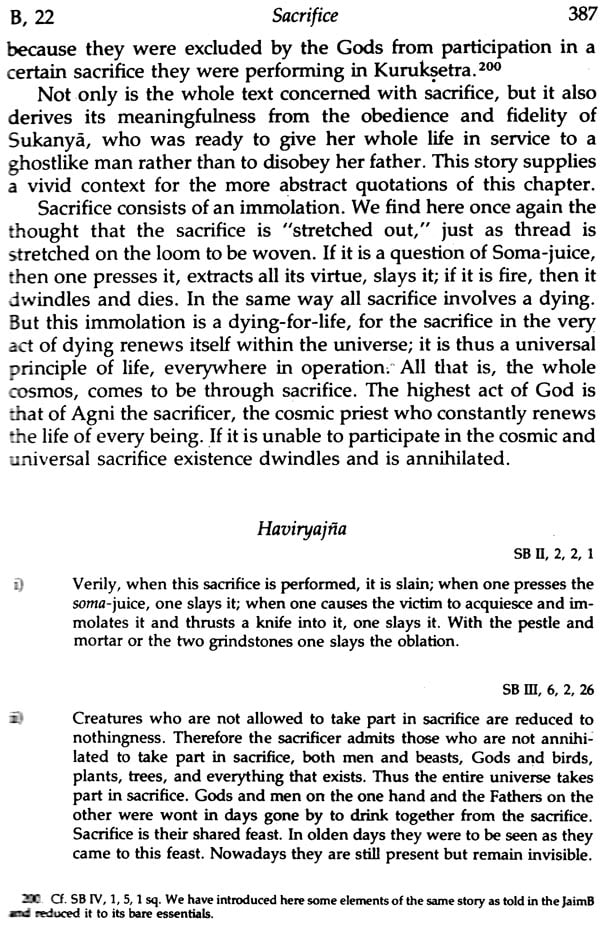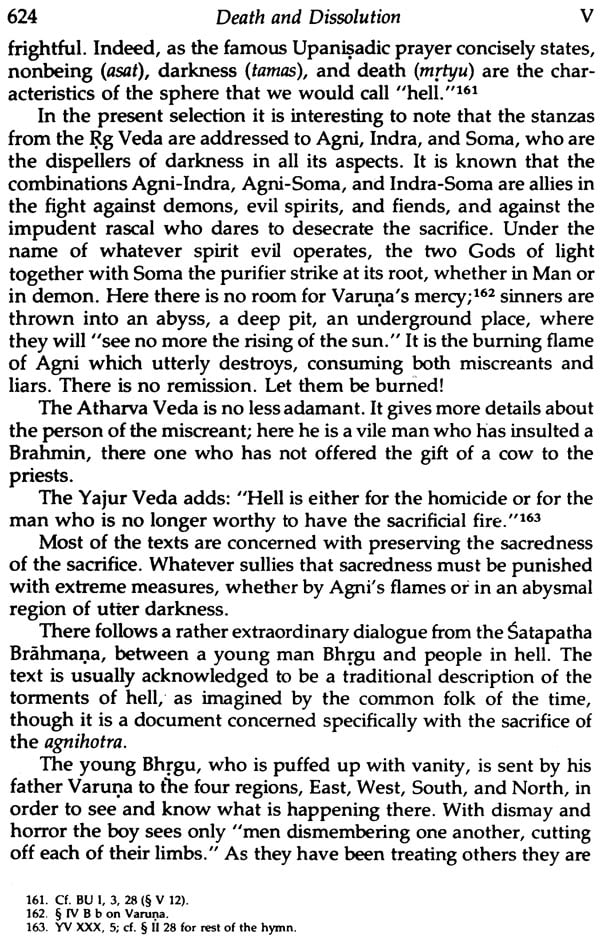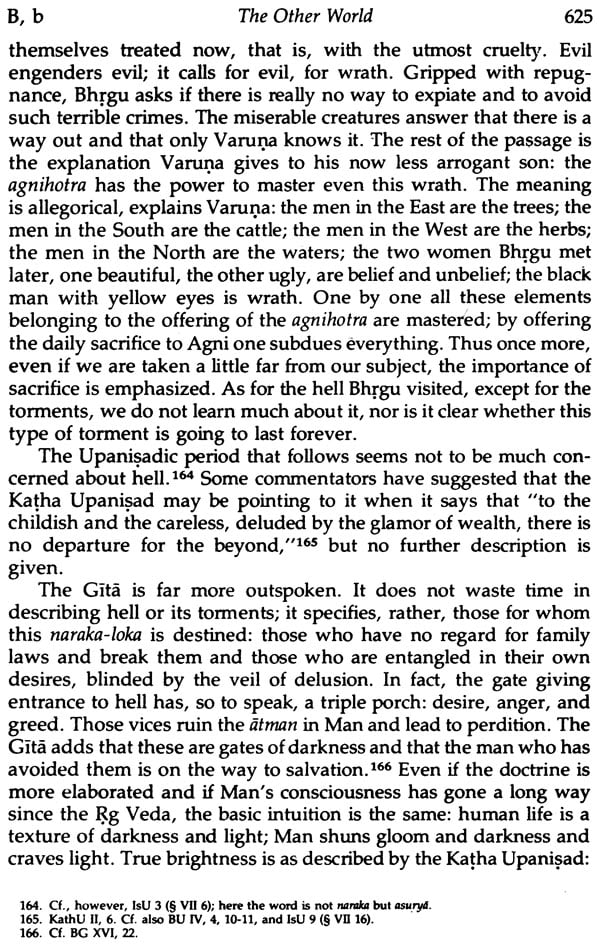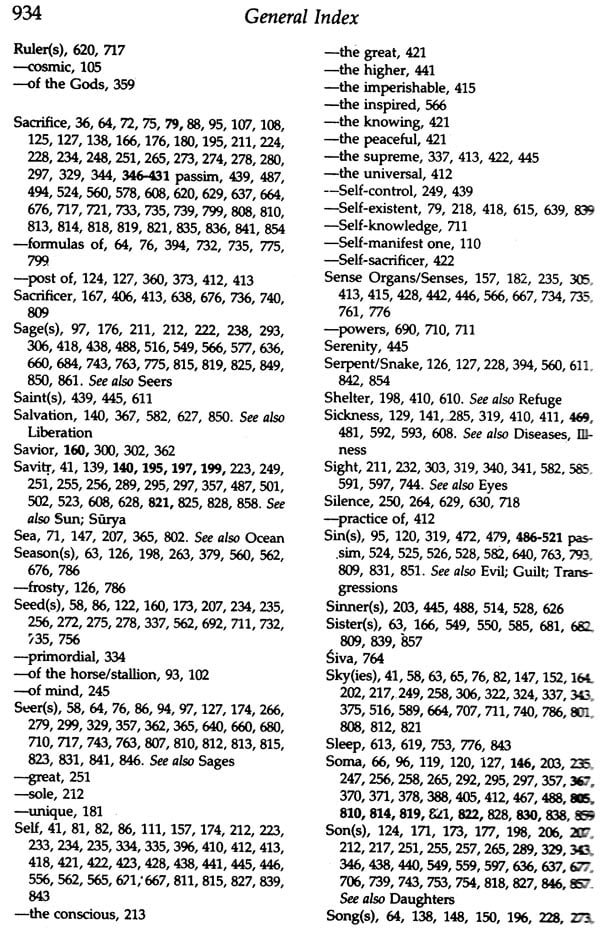
The Vedic Experience Mantramanjari – An Anthology of the Vedas for Modern Man and Contemporary Celebration
Book Specification
| Item Code: | IHL582 |
| Author: | Raimundo Panikkar |
| Publisher: | Motilal Banarsidass Publishers Pvt. Ltd. |
| Language: | English |
| Edition: | 2016 |
| ISBN: | 9788120812802 |
| Pages: | 975 |
| Cover: | Hardcover |
| Other Details | 8.8 inch X 5.8 inch |
| Weight | 1.20 kg |
Book Description
One of the most stupendous manifestations of the Spirit; is undoubtedly that which has been handed down to us under the generic name of the Vedas. The Vedas are still too much neglected not only in the world at large but also in their country of origin. This Vedic anthology will make direct and fruitful knowledge of the Vedas available to a wider range of people than the small elite of pandits and indologists.
This anthology collects the most crucial texts of the Indian Sacred Scriptures—in all more than 500—newly translated into contemporary English. Dr. Panikkar’s principle has been to select and place together texts so as to offer a selection of texts that cover the full range of ‘The Vedic Experience’ and at the same time to show how they manifest the universal rhythms of nature, history, and Man. Excerpts are taken from the oldest hymns, such as the Rig Veda; from the Brahmanas the Aranyakas, or "Forest Treatises, " and finally the Upanisads, which represent the mystical and philosophical culmination of the Vedas.
This is a book for meditation, for reading, public and private, as well as for thorough study at this wellspring of human wisdom. It should, moreover, facilitate that meeting of East and West so long desired and delayed, and now so imperative.
Raimundo Panikkar is Professor of religious studies at the University of California, Santa Barbara. His books include The Unknown Christ of Hinduism, Worship and Secular Man, The Trinity and the Religious experience o man, The Intrareligious Dialogue and Myth, Faith and Hermeneutics.
What would you save from a blazing house? A precious, irreplaceable manuscript containing a message of salvation for man- kind, or a little group of people menaced by the same fire? The situation is real and not for this writer alone: How can you be just an "intellectual," concerned with truth, or just a "spiritual/’ busy with goodness, when Men desperately cry for food and justice? How can you follow a contemplative, philosophical, or even religious path when the world shouts for action, engagement, and politics? And, conversely, how can you agitate for a better world or for the necessary revolution when what is most needed is serene insight and right evaluation? That the burning house is not my private property should be clear to all my neighbors on this earth of ours. But to speak about myself alone: this anthology is the product of an existential overcoming of my concrete situation by denying the ultimate validity of such a dilemma. If I am not ready to save the manuscript from the fire, that is, if I do not take my intellectual vocation seriously, putting it before everything else even at the risk of appearing inhuman, then I am also incapable of helping people in more concrete and proximate ways. Conversely, if I am not alert and ready to save people from a conflagration, that is to say, if I do not take my spiritual calling in all earnestness, sacrificing to it all else, even my own life, then I shall be unable to help in rescuing the manuscript. If I do not involve myself in the concrete issues of my time, and if I do not open my house to all the winds of the world, then anything l may produce from an ivory tower will be barren and cursed. Yet if I do not shut doors and windows in order to concentrate on this work, then I will not be able to offer anything of value to my neighbors.
Indeed, the manuscript may emerge charred and the people may emerge blistered, but the intensity of the one concern has helped me in the other. The dilemma is not whether to choose the Monastery or the Ballroom, Hardwar or Chanakyapuri (Vatican or Quirinal), Tradition or Progress, Politics or Academia, Church or State, justice or Truth. In a word, reality is not a matter of either or, spirit or matter, contemplation or action, written message or living people, East or West, theory or praxis or, for that matter, the divine or the human. Indeed, perhaps the fundamental insight of this book is that there is no essence without existence, no existence without an essence.
This study emerges out of an existential struggle between concentrating on the writing of it at the risk of letting people be trapped in the tire, and helping persons out of the house at the price of abandoning the manuscript altogether. The act of faith behind this study is to have denied the inevitability of a choice, not by an act of the will alone or of the mind alone, but by allowing circumstances to guide my intellect, my spirit, and indeed my whole life. Is not the entire Vedic experience based on life-giving sacrifice?
When, a decade ago, the urgent and long-standing need for a study to this kind pressed on me so hard that it could no longer be resisted, a tantalizing alternative seemed to present itself: either to become a trained mechanic, in Sanskrit and English at least, or else to become a trusty pilot in Vedic and other personal flights. Circum- stances again decided for me, and this work has been rendered possible by the unusual team of people collaborating with me. One could hardly have found a more unselfish and devoted group of helpers than the one that has made this anthology possible. One does not fly alone.
First of all, I want to thank the group of collaborators. N. Snanta, to whom this anthology is dedicated, has been decisive in deter— mining the entire gestalt of the book. M. Rogers has revised the style, especially allowing the texts to reflect the beauty of the original through the genius of the English language. B. Baumer and M. Bidoli have gone through the Sanskrit texts and contributed creatively to an accurate version of them. Without these collaborators this anthology could not have been completed.
Thanks are also given to a living artist, to a modern scholar, and also to an ancient monk. The entrance mandala and the vignettes of the book are original of A. Kunze who, according to tradition, drew them while meditating on the texts. The Sanskrit syllables appearing in some of the drawings are bija-mantras, which symbolize, at least partially, the meaning of the corresponding section.
The Devanagari letters illustrating the anthology are reproductions of original xylographs belonging to Sri Lokesh Chandra, Director of the International Academy of Indian Culture, New- Delhi. They are from Shuji—shu, a Japanese "Collection of bijas" woodprinted by Bhiksu Chozen in A.D. 1661-1673. They are also bija—mantras, that is, mystical syllables or aksara devatas, each of them symbolizing some Vedic deity as indicated below the reproduction. Without R. H. Hooker and U. M. Vesci, many a blunder would have remained unchecked; without R. S. Bhattacharya, P. Y. Desh-pandey, D. Mumford, and many other friends the book would not have reached its present form. Nor do I forget K. V. C. Subramanyan and A. K. Karmakar, who have typed and retyped the manuscript so many times that they know many of its mantras by heart.
I have also to thank the Vedic Gods and all other spirits who have blessed this venture. I ask them and the reader to pardon the chasm that exists between the real mantra and this marijari. May both Gods and readers by their acceptance of this mantramanjari for- give and forget its compiler so that the silent, Divine Mystery may flow freely through whatever living mantras this anthology may elicit. The feelings of humility, which in many prefaces are some- what perfunctorily expressed, are in this instance both genuine and overwhelming. How is it possible to touch upon almost all the relevant and central problems of Man, over a time span of at least four millennia, and to dare to present a seed that may germinate elsewhere and a beam capable of setting light to what it touches? If this is so, then even the decade of life and work compressed into this anthology would be no more than a foolish undertaking or an impossible task. How could I venture even to attempt what I have done? I simply wonder at my daring. But, having done something of which I may well repent, I still hope that some readers will not regret that I could not have done otherwise.
| First Mantra | 36 | |
| The Gayatri | 38 | |
| I: Dawn and Birth | ||
| A. | Prelude | 49 |
| B. | The Word | 88 |
| C. | The Elements | 113 |
| (a) Waters | 116 | |
| (b) Earth | 120 | |
| (c) Wind | 130 | |
| D. | The Lord | 133 |
| E. | Emerging Life | 161 |
| (a) Dawn | 163 | |
| (b) Human Birth | 170 | |
| (c) Faith | 178 | |
| II: Germination and Growth | ||
| A. | The First Blessings of the Lord | 191 |
| (a) Divine Gifts | 193 | |
| (b) Food | 224 | |
| B. | Awakening and Coming of Age | 238 |
| (a) Initiation into Human Life | 241 | |
| (b) Growing into one | 253 | |
| C. | The World of Man | 266 |
| (a) Knowing the Earth | 268 | |
| (b) Human Work | 276 | |
| (c) The Happy Life | 282 | |
| III: Blossoming and Fullness | ||
| A. | Radiance and Cosmic Refulgence | 313 |
| (a) Divine Splendor | 315 | |
| (b) Cosmic Splendor in Man | 338 | |
| B. | Sacrifice | 346 |
| C. | Breaking the Boundaries | 432 |
| IV: Fall and Decay | ||
| A. | Sorrow and Suffering | 459 |
| (a) Physical Ailments | 462 | |
| (b) The obstruction on the Way | 474 | |
| B. | Sin and Mercy | 482 |
| (a) Evil and Fear | 490 | |
| (b) The Merciful Lord | 506 | |
| (c) Purification | 518 | |
| V: Death and Dissolution | ||
| A. | The Great Departure | 538 |
| (a) The Mystery of the Beyond | 542 | |
| (b) The Blessings for the Journey | 574 | |
| (c) Liturgy for the Dead | 600 | |
| B. | The Other World | 613 |
| (a) Cosmic Disintegration | 616 | |
| (b) Hell | 623 | |
| (c) Heaven | 631 | |
| VI: New Life and Freedom | ||
| A. | The Ascending Way | 652 |
| (a) Toward the One | 553 | |
| (b) Transcendental Consciousness | 669 | |
| B. | The Internal Way | 696 |
| (a) The Discovery of the Ground | 697 | |
| (b) The Disclosure of the Subject | 725 | |
| C. | The The Encounter | 746 |
| (a) The Fulfillment of the Person | 747 | |
| (b) The Absolute Simplicity | 766 | |
| VII: Twilight | ||
| A. | At Sunrise | 795 |
| (a) Spring | 801 | |
| (b) Summer | 807 | |
| (c) Rainy Season | 812 | |
| (d) Autumn | 816 | |
| (e) Winter | 820 | |
| (f) Frosty Season | 824 | |
| B. | At Sunset | 832 |
| (a) Spring | 837 | |
| (b) Summer | 840 | |
| (c) Rainy Season | 844 | |
| (d) Autumn | 849 | |
| (e) Winter | 853 | |
| (f) Frosty Season | 856 | |
| Last Mantra | 862 |
